Foot & Ankle
- Anatomy
- Conditions
- Procedures
What is the Normal Anatomy of the Foot and Ankle?
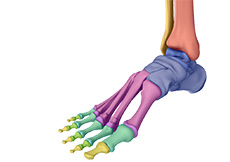
The foot and ankle is a complex joint involved in movement and providing stability and balance to the body. The foot and ankle consist of 26 bones, 33 joints, and many muscles, tendons and ligaments.
Bones of the Ankle The ankle joint connects the leg with the foot and is composed of three bones: tibia, fibula and talus. The tibia or shinbone and fibula or calf bone are bones of the lower leg which articulate with the talus or ankle bone, enabling up and down movement of the foot.
Foot and Ankle Arthritis
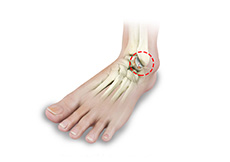
Arthritis is inflammation resulting from the degeneration of cartilage in the joint causing joint pain, swelling, and stiffness resulting in restricted movements. Arthritis of the foot and ankle joint can occur due to fractures, dislocation, inflammatory disease, or congenital deformity.
Diabetic Foot
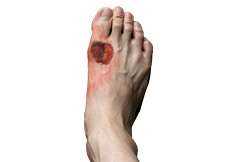
Foot problems are a common complication of Diabetes. Diabetes is a disease that affects how the body uses glucose, a sugar that is a source of fuel for the body. Normally, insulin, a hormone, helps glucose get into the body cells so that it is used for energy.
Plantar Fasciitis
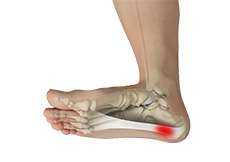
Plantar fasciitis is a painful foot condition. It occurs when connective tissue at the bottom of the foot, called the plantar fascia, is irritated and inflamed. The condition commonly occurs among people who spend a lot of time on their feet.
Achilles Tendon Tear & Repair
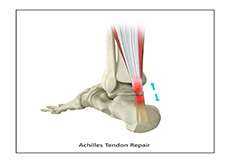
The Achilles tendon is the most powerful tendon in the human body. Tendons are strong tissues that connect muscles to bone. The Achilles tendon is located in the lower back part of the leg and works with the calf muscles to provide forceful foot movements.
Hindfoot Fracture (Heel/Ankle Joint)
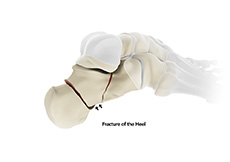
It takes a lot of force to fracture the bones in the hindfoot. A fracture is a broken bone. Injuries most frequently result from car crashes or falls from a significant height. Fractures may occur in the heel or the bone located on top of the heel. Hindfoot fractures take a long time to heal, with or without surgery.
Bunion
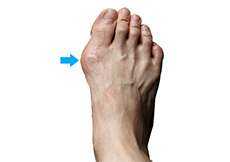
Bunions are a common foot deformity, especially in females. They most frequently result from wearing shoes that are too small and or have a high heel. Abnormal pressure from poor fitting shoes causes the bones in the big toe and foot to move out of position.
Claw Toe
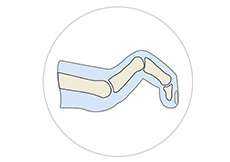
Claw toe most frequently develops in older women. It causes the joint at the base of the toe to bend upward and the other joints on the toe to bend downward in the shape of a claw. Claw toe may be related to underlying medical conditions or caused from wearing poor fitting shoes.
Hammer Toe
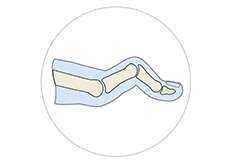
Hammertoe most commonly affects the second toe on the foot. It causes the middle joint to bend. Hammertoe is most frequently caused by structural problems in the toe or from wearing poor fitting shoes. It is important to diagnose and treat hammertoe early because the condition tends to become worse over time. If left untreated, hammertoe can require surgery.
Morton's Neuroma (Foot)
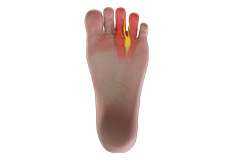
Morton’s Neuroma is a painful foot condition. It occurs when a nerve near the toes becomes compressed and inflamed. If diagnosed early, most cases of Morton’s Neuroma can be treated without surgery.
Achilles Tendon Tear & Repair

The Achilles tendon is the most powerful tendon in the human body. Tendons are strong tissues that connect muscles to bone. The Achilles tendon is located in the lower back part of the leg and works with the calf muscles to provide forceful foot movements.
Posterior Tibial Tendon Dysfunction - Acquired Flatfoot
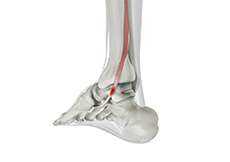
Posterior tibial tendon dysfunction, also known as acquired flatfoot, results when the tendon at the back of the ankle is inflamed or torn. It is a progressive condition that can eventually lead to a fallen arch or flatfoot. Advanced cases, or those that do not respond to non-surgical treatments, may require surgery. There are various surgical procedures for posterior tibial tendon dysfunction, and it is common to need more than one.
Charcot Foot Deformity
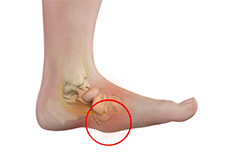
Coming soon.
Ankle Replacement
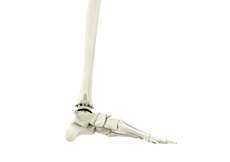
Total ankle replacement surgery, or ankle arthroplasty, can improve ankle function and relieve severe pain caused by arthritis and other conditions. As more FDA-approved ankle implants have become available, ankle replacement has become the preferred alternative to ankle fusion.
Ankle Arthroscopy
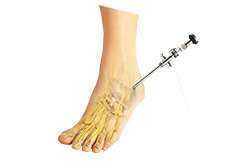
Ankle arthroscopy is a minimally invasive surgical procedure in which an arthroscope, a small, soft, flexible tube with a light and video camera at the end, is inserted into the ankle joint to evaluate and treat a variety of conditions. An arthroscope is a small, fiber-optic instrument consisting of a lens, light source, and video camera. The camera projects an image of the inside of the joint onto a large screen monitor allowing the surgeon to look for any damage, assess the type of injury, and repair the problem.
Platelet-Rich Plasma (PRP) Therapy
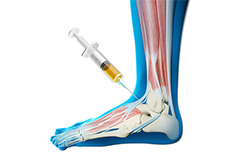
Platelet-rich plasma (PRP) therapy is an exciting new treatment that relieves pain and promotes long-lasting healing of musculoskeletal conditions. Our doctors offer this amazing noninvasive procedure right here at South Palm Orthopedics.
Achilles Tendon Tear & Repair

The Achilles tendon is the most powerful tendon in the human body. Tendons are strong tissues that connect muscles to bone. The Achilles tendon is located in the lower back part of the leg and works with the calf muscles to provide forceful foot movements.
Complex Foot and Ankle Reconstruction
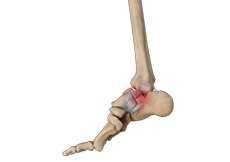
Complex foot and ankle reconstruction is a surgery performed to correct the structures of the foot and ankle to restore the natural functionality of the foot that has been lost due to complex injury, fracture, or disorder.
Fracture Repair
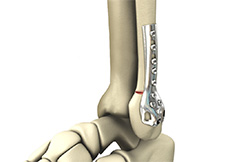
Fracture repair is a procedure performed to heal broken (fractured) bones using conservative or surgical treatment methods. This procedure mainly focuses on the reduction of the fracture and holding the fractured ends of the bone in the proper position during the healing process to ensure normal function after the fracture heals.
Injections and Medications
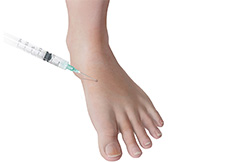
Foot injections are steroids that are injected into your foot to relieve pain and inflammation. Cortisol is a hormone that is produced in the human body and functions to reduce stress and inflammation. Steroids are synthetic drugs that resemble cortisol and are used in treating joint pain.
